circa. 1974
While researching solar power for home heating, as an undergrad project
at university in the UK, I discovered the existence of heatpumps and concluded
they would be a good way to raise the temperature of water from a solar
collector to that of a domestic hot water supply.
circa. 1982
In Canada, I actually see a heatpump for sale, maybe at Sears. Large, expensive,
not exactly clear how it connects to a house. Probably a ducted air type.
See small window and Wall-mounted air conditioner units in motels. They only cool
- not usually a problem in Vancouver.
Build a house in Vancouver, to near-R2000 program efficiency standards (without the electric outlet gaskets and air-tight testing), using ESWA radiant heat ceiling panels. Designed to warm the room occupants directly by thermal infra-red radiation from above. Unobtrusive, dust-free.

circa. 1986
Install an air-exchange heat exchanger and ductwork to control condensation and to
allow required air changes without leaving windows open. Part of the R2000 standard; traditional
home construction was assumed to have enough natural air leakage around doors, fittings etc. not
to need ventilation.
circa. 1990-2014
ESWA panels gradually dying. One almost immediately due to improper construction. By 2014, only 2
rooms have working panels and others are heated as required with portable oil-filled electric
heaters.
circa. 2009
On a FortisBC website, possibly
this one
(on archive.org),
find a study, possibly
this PDF
(on archive.org),
showing that a ground-sourced heatpump is the most efficient form of gas or electric
active home heating. Viz.
| Estimated Annual Energy Cost to heat a 5000 sq.ft. office building | |||
|---|---|---|---|
| FUEL/Furnace | Seasonal Efficiency | Units Req'd | Annual Cost |
| Ground Source Heat Pump | 300% | 15,200 kWh | $767 |
| Air Source Heat Pump | 175% | 21,714 kWh | $1,095 |
| Natural Gas (high efficiency) | 95% | 144 GJ | $1,791 |
| Electric Resistance | 100% | 38,000 kWh | $1,917 |
| Natural Gas (mid efficiency) | 78% | 175GJ | $2,125 |
| Natural Gas (standard) | 60% | 228 GJ | $2,684 |
circa. Nov 2014
Browsing the BC Hydro website, possibly looking for information
on the smart meter program and/or our electricity bill, come across
a rebate program
for heating system upgrades, such as replacement of electric baseboard heaters.
This offers $800 for installation of a ductless heat pump, and mentions mini-split systems.
What's a mini-split system?
After some searching on the Web, find e.g.
mini-splits.ca.
There don't seem to be any dealers or showrooms within easy driving distance.
I still haven't actually seen one.
Find a dealer a bit further away; quoted $3000/room, ballpark, installed. Hmm; the ROI on that doesn't
seem so good if I'm only saving about $800/year.
Find sogoodtobuy.com with online prices in Canadian dollars. About $1000 for a unit; that seems a bit better.
December 2014
More research. Looking at AHRI per the rebate details,
and e.g.
nrcan.gc.ca/efficiency
and ahridirectory.org, consider the Senville AURA series.
How to install the thing ? How big is it ? What does it need ? Turns out it needs 240V AC, and an outside wall. The website shows the indoor units about 3ft long and 1ft high, mounted high-up. Spend some time thinking about how to do that - the 240V requirement means I can't just connect it to an existing circuit feeding wall outlets, which is all that is available on the outside walls. I don't want to tear up the wallboard inside, and I don't want to run cable down the outside either - I want the cable runs concealed, e.g. fished down inside a wall somewhere. There's 240V available (120V split-phase, according to wikipedia) - the ESWA panels use that, and the stove/dryer. So I need to get a wire from the breaker panel to an outside wall where I can mount a compressor unit outside and a heating unit inside, where neither will get in the way. More thought. The breaker panel has easy access to the attic, which is where the ESWA panels for upstairs rooms are located. The heating units appear overspecified for just one room. Can I run a cable down inside the chimney cladding, and fit a heating unit in the wall between two rooms to serve both ? Somehow the chimney doesn't seem such a good idea (even if it is only used once or twice a year), even if it is made of wood (I grew up in the UK; the idea of a wooden chimney seemed hilarious). Yet more thought. Find the multi-zone units (two or more indoor units per outdoor unit). That makes more sense than trying to fit a unit into a wall.
The rooms that we use most, where the ESWA no longer works, are the sitting room, dining room
and master bedroom. So it makes sense to fit a heatpump in at least one of those, and possibly consider
other rooms later depending how the project works out and what the real return on investment is.
The master bedroom is above the dining room, more-or-less, and there's an outside
wall. It's quite easy to get 240V there across the attic and down the line of the roof to the soffit,
and there's access inside (where I had fitted some air exchange ductwork). Looks like a good
fit for a dual-zone AURA.

The sitting room is a bit harder. Fishing cable down the walls would require tearing open the wall to drill
through the bedroom floor and wall headers, which I don't really want to do. There's a
part cathedral ceiling and a stairwell that might work. Fishing down the stairwell wall would
probably require tearing the wall open to locate and drill at least one horizontal wood
stud. The line between the cathedral ceiling and the roof looks promising. After some
measurements and consideration, I decide that it must be possible.

Later
Bite the bullet and actually order something from sogoodtobuy, for about $3200 USD:
1 x Senville 18000 BTU Dual Zone Aura Series (kitchen + bedroom) 1 x Senville 9000 BTU Aura Series (sitting room) 1 x SL-550 brackets 1 x HA-550 brackets
Turns out the Senville 9000 is out of stock so they will upgrade it to a 12000 at no charge.
It's coming halfway across Canada, from Quebec, on a truck. ETA a bit over a week.
Finally it arrives, just in time for Christmas, on a pallet covered in plastic wrap.
Or rather, just in time for me not to have
time to work on it due to the holidays. Besides, I have the 'flu.

January 2015
Unpacking. Received (in separate cardboard boxes):
1 x SL-550 brackets 1 x HA-550 brackets 1 x PJX-02(4) 13ft refrigerant lines 2 x PJX-01(4) 13ft refrigerant lines 2 x SENA/09HF/I (indoor unit) 1 x SENA/12HF/I (indoor unit) 1 x SENA/18HF/MO (multi-zone outdoor unit) 1 x SENA/12HF/O (outdoor unit)Figure out the brackets. I'd ordered the ones recommended on the website for the two outdoor units; one is a bit stronger than the other with a horizontal bar. The support legs for the outdoor units are welded in place on about a 21" pitch. The wall studs on my house are on a 24" pitch. That means the smaller brackets won't really work. I decide to mount the larger outdoor unit on the concrete pad (relic of a septic tank system) and use its brackets for the smaller one - I drilled holes in the horizontal bar to match the stud spacing and use lag bolts to secure that to the wall.
I made some measurements and figured out where the indoor units for dining room and bedroom
could go so they would be vertically above each other - the bedroom one near an end wall
and the dining room one midway along the wall near a cupboard. Then I picked a spot for
the outside unit, marked the holes in the feet, and drilled holes in the concrete
with a hammer drill to take anchor bolts. In retrospect, I should have used a jig
since the drill moved slightly while drilling and the holes did not quite line up
- I had to file the feet slightly. I mounted the unit on some nylon pads so that the
metal feet did not actually sit in a film of water in the "rainy season".
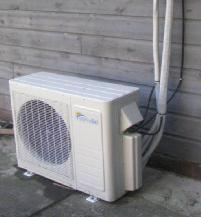
The electrical power requirements for the units are quite modest - that's the whole point, after all. About 4A for the one-zone and 6A for the dual-zone unit. I fitted a 240V 16A outlet into the soffit above the outdoor unit and ran cable up the line of the roof into the attic and across to the breaker panel used for the failed ESWA heating panels, so that the breaker assignments would be basically the same (sitting room, bedroom etc.).
The indoor units are designed to hang on a wall. They come with a mounting plate
arranged so that the unit drops over a hook at the top and hinges on that to allow
access to the coolant pipes, then closes with a latch at the bottom. The mounting
plate is designed to be screwed to the wall. As stated previously, the
wall studs are on a 24" pitch, but the vertical elements of the mounting
plate are on an 18" pitch. I wanted to mount the unit flush, without cutting
into the wall or adding a plywood support plate proud of the wallboard.
The unit is not especially heavy, so I made a sheet steel extension to reach to
the next stud, screwing one leg of the mounting plate to a stud and the other
to wallboard with a cavity toggle.

After examining the units and reading the installation instructions, the setup becomes a bit more clear. The following have to pass through the wall:
- Condensate drain
- Refrigerant supply line
- Refrigerant return line
- 240V supply (2x 120V split-phase wires to power the indoor unit)
- Signal wire (to control the compressor)
- Ground wire (to ground the indoor unit)
The units come with a pre-terminated 13ft cable to link the inside and outside units. The terminations don't fit, and the cable is 3-conductor while with the ground, I need 4 conductors. I strip the terminators since the unit takes bare wire ends, and run a separate ground wire. The indoor unit is powered via the outdoor unit, not directly, so there is only one connection to the 240V supply.
The indoor units come with stubs for the refrigerant lines, pre-terminated with flare
nut fittings and folded along inside the back of the unit. The instructions show
a procedure for connecting the lines and tightening the nuts in this position.
In retrospect, after finding a youtube video later, it's clear that for the
dining room unit I should have unfolded the coolant stubs and passed them through
the wall, making the connections on the outside, which would have been much easier.
In the event, I drilled separate holes for the condensate and coolant lines, brought
the 13ft lines through the wall, made 90 degree corners with a pipe bending tool,
and made the joins in the rear of the unit as shown in the instructions.
One false start - having chosen one side of the plate to screw to a stud, it
transpired that the hole for the coolant lines would hit another stud, so
I had to shift the unit 6" to the side, leaving a small screw hole to patch later.

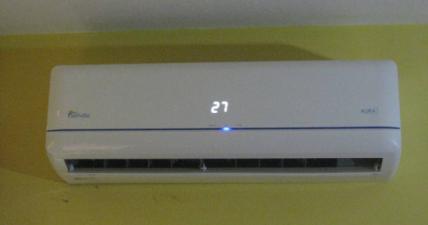
The installation instructions specify a certain torque for the flare nut connections.
I have a torque wrench, but it is designed for 1/2" drive sockets, not flare nuts.
After exploring the possibility of a crow-foot wrench, I decide the easiest method is
to use a spring balance with a wrench of known length. The smaller unit pairs
use 1/4" pipe for coolant supply and 3/8" pipe for coolant return; the larger one
uses 1/2" pipe for return. The flare nuts on the pipes and on the stubs are different
sizes, meaning I need about 4 different sizes of wrench (some of the gas fittings on
the outdoor units are yet another size). I find that such a thing as a flare nut
wrench exists, designed to slip over a pipe and then bear on 4 sides of a nut, not just
2 as for a flat wrench. This seems a good idea, so I buy a set of 3. But that does not
include the 2 larger sizes I need. So I buy a couple of ring spanners and cut the
ring with a carbide disk to turn them into flare nut wrenches; that works quite well.

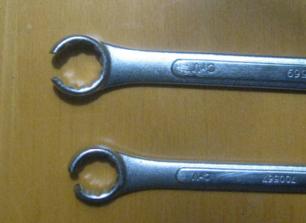
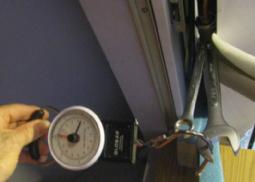
| Pipe Diam. | Wrench size | Wrench length | Torque (kgf.cm) | Force(kgf) |
|---|---|---|---|---|
| 1/2" | 24mm | 27cm | 357 | 13.2 |
| 1/2" | ? | 17cm | 357 | 21 |
| 3/8" | 22mm | 22cm | 255 | 11.6 |
| 3/8" | ? | 17cm | 255 | 15 |
| 1/4"" | 17mm | 17cm | 153 | 9 |
| 1/4" | ? | 15cm | 153 | 10.2 |
The unit in the bedroom was not against an outside wall, but against a stub wall above a closet.
In this case, there were studs at an 18" spacing. I again drilled two holes, one for the condensate
drain and one for the coolant lines. The condensate line was led through the wall, then after a 90 degree bend,
through the end wall to drain onto a deck. The hole through the end wall in the location I had
chosen turned out to be partly through a stud rather than through fibreglass batt insulation as
in the dining room. I used a length of poly water pipe to support the flexible condensate hose.
The coolant lines and electric cables run across the top of the closet; I used a length of
2.5" diameter ABS pipe to conceal and support the lines. The lines then run down the line of the roof
through the fibreglass insulation batts, then vertically down through the soffit to the outdoor unit.



Siting the heatpump set for the sitting room proved a bit more complex,
as anticipated. The house has a steep roof that comes down to the level of the ground-floor
ceiling, and seen from above has a truncated cross shape with four valleys between the roof
sections. There is a partial cathedral roof with skylights above
the sitting room. Originally I wanted to mount the indoor unit above a cupboard, with all
the lines concealed within the dead space above the cupboard, but there was no easy access
to this space, and also it appeared that there was no stud to secure the unit to. I considered
the side wall, but realized that it would be impossible to fit the coolant lines
without removing large area of tongue-and-groove soffit. Finally I reverted to my first
choice for location, when it became apparent that there was in fact some timber
framing under the wallboard, and routed the coolant lines out the side of the unit,
where they are exposed to view but partly hidden by the unit itself from most
angles.

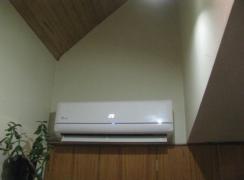
Routing the 240V supply line also proved problematic. I tried to fish down the inside edge of the gable end, but after drilling a 1" diameter hole to gain access, found there was timber blocking the space lower down. Eventually I was able to push a rope down through the insulation batts between two skylights, using two 7ft wooden battens fastened end-to-end (there not being enough room in the attic to insert a single longer batten), and hook the rope from below after removing a section of siding to gain access to the area above the soffit. It was then fairly simple to pull the electric cable and wire an outlet box.
The outdoor unit here was mounted on the wall using the larger pair of brackets, using
lag bolts into the wall studs. The unit came with a set of fairly rigid-looking
rubber spacers which are supposed to dampen vibration, and indeed I have not noticed
any vibration transmitted through the wall. The slightly larger SENA/12HF uses 1/2"
copper line for the coolant return, which I bent with a spring as the bending
tool used for the smaller 1/4" and 3/8" line did not accommodate the larger size.
As with the other units, I cut the copper lines to length and re-flared the ends
with a flaring tool before assembling the joints with the flare nuts provided.
The lines were pre-assembled with Siamese twin foam plastic insulation;
I cut this in order to make the 90-degree bends and then re-fitted it.
After shortening two of the 13ft lines, I had enough spare insulation for the 19ft line
to the bedroom. The kit also contained rolls of a grey plastic wrapping
tape which is used to wrap the insulated lines together with the communicating electric
cable.
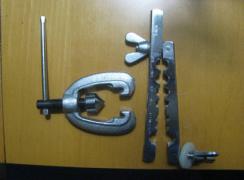
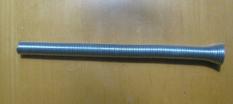
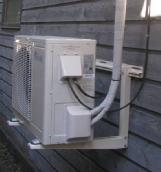
February 2015
With everything connected up, the final step was to purge the coolant lines and open the
valves to let the refrigerant in - the outdoor units were pre-charged with R410A.
The installation instructions say to connect a vacuum pump to a fitting on the outdoor unit,
pump down the lines to vacuum and allow any moisture to evaporate, then open the valves.
I made an attempt to engage an HVAC contractor to do this, and played phone tag for a few
days, but gave up. He had not heard of the Senville brand. Then, since I had access to
a vacuum pump, I decided to do it myself. After arranging to borrow a pump, I was
surprised to find that the thread on the access ports did not match any of the flare nut
sizes. I tried several local stores, and could not match the thread at all - it
did not seem to match standard plumbing or compressed air fittings. I had an
automotive refrigerant coupling, but that used a snap-on type rather than a threaded connection.
After some more research, I determined that the coupling probably matched a US brand
"yellowjacket" connector, with a Schrader opener (since the coupling on the unit has
a Schrader valve, like a car tire). I could not find any local suppliers - Vancouver
not being particularly hot, it was hard to find a hardware store that had even heard
of these fittings, let alone stocked them. Finally I measured the apparent size of the
coupling - 3/8" - and ordered a connector online from the US. When this arrived after a bit more
than a week, it was obviously too large, and also missing the Schrader opener. But in original
packaging, marked 3/8". Clearly "everyone knows" that the 3/8 refers to something other than
the actual coupler dimensions - the supplier had no engineering drawings or dimensions
online, only photographs with no scale.
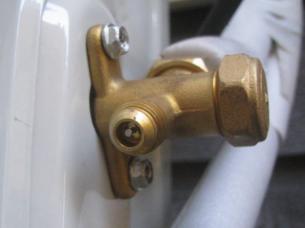
So I made another attempt to find a coupler locally. I found a plumbing store that stocked
HVAC gauge sets and hoses, which looked about right - with a Schrader opener - but turned
out to be slightly too small. Then an automotive store was able to identify the thread - 5/16"
pipe. Armed with this information, I spent most of an afternoon riding around Vancouver trying
various hardware and plumbing stores to no avail. Finally I returned to the automotive
store and found the selection of pipe fittings that matched the thread. I found a hose
adaptor that would work, tapped the inside to an M6 thread, and made a Schrader opener
from a slotted bolt.



I borrowed a roughing pump from a research lab, along with a valve and electronic pressure
gauge. These all use standard high-vacuum fittings with O-rings, mating flanges
and quick-release clamps. To convert to the gas line fittings, I had some 1/4" copper line,
and thick-walled rubber hose with hose clamps. The heatpump instructions call for the lines
(and indoor unit to be pumped down to rough vacuum (about 1 torr) and left to outgas for
15 minutes. I ran the pump rather longer than that (maybe an hour) and then
after closing the valve the pressure rose to about 8 torr and stayed there, which
I thought was good enough (atmosphere is 1000 torr). Since the electronic gauge only shows
pressure below atmospheric, I changed the setup to include an automotive HVAC gauge,
and opened the packed valve on the heatpump unit to allow refrigerant to enter the lines.
The hose started to leak under positive pressure, so I quickly removed the coupling which
allowed the Schrader valve to close and sealed the system.
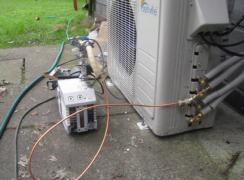
I had used a thick extension cord to power the pump; when I moved to the second
outdoor unit, that would not reach so added a second extension cord.
That probably had too much resistance, and the pump would not run properly.
When I removed the second cord moved to a nearer outlet, the breaker popped.
I guess the pump was taking about 12A and there were too many other loads on
the same circuit. I tried turning off loads to no avail and finally ran
the extension cord through a window to an outlet on a different circuit.
Then I repeated the pumping procedure on the second unit. By this time it had
started to rain slightly so I erected a portable shelter across everything.
After opening the packing valves, I did the recommended leak test with soapy
water, and then was finally able to seat the indoor units properly against
the wall and fit the covers on the outdoor units.

When I powered up the dining room and bedroom pair, everything seemed to work fine. But the unit in the sitting room initially would not start. I suspect now that being mounted higher up, the ambient temperature was higher and I had not selected a high enough setting on the remote control.
I wrote this up on Instructables, and had some comments from, I think, a US-based A/C professional criticising the commissioning and leak-testing procedure. Specifically that one should not test for leaks with soap but rather do an over-pressure test with dry nitrogen. Which I admit seems better - I had followed the procedures from the Senville installation instructions, which appears to be a US-based company, so I was surprised they don't meet current US standards.
But does it save money?
Good question. If I cherry-pick the data, then yes. But in spring 2015 when
the system was turned on, there were less bedrooms occupied in the house,
so the lower electricity consumption is perhaps not surprising. The childrens'
bedrooms are still heated with resistive electric heat, and in
November 2015 with them occupied, the total consumption is
actually higher than November 2014 when they were not.
